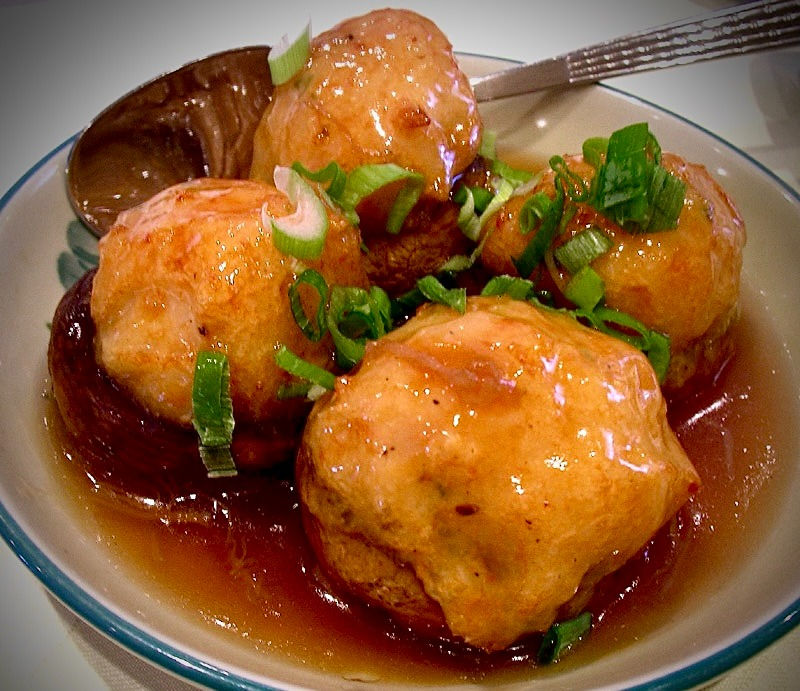Farcis, à la French or Chinese?
- xubeimail
- Dec 2, 2022
- 4 min read
Sun, breeze, and a little cat quietly walking in his territory along the swimming pool… On the side of the garden in front of the house, Jacqueline is setting the lunch table, decorating it with colourful olive plates while my father is opening the awning. Jean-Michel and my mum are finalising two different versions of farcis (stuffed vegetables), one is French, the other is Chinese.
We are at Nathalie’s parents’ home in South-West France. The friendship between her and I dated back to high school, one in France, the other in China. Our parents also started theirs, meeting for the first time in 2008 at my parents’. Having quickly bonded, the two French who didn’t speak Chinese and the two Chinese who didn’t speak French even went to the local market all four of them. Obviously mastering the language was not required to understand food, even though some vegetables and fruits were typically Chinese, and meat and fish were displayed very differently from France. Later, each time when my parents came to France, arranging a stay all together with Nathalie’s parents has become our ritual.
Throughout all these years’ friendship, my parents have also discovered French cuisine via these convivial moments in family – no better way to encounter another culinary culture. The farcis were one of their favourites. After all, who doesn’t like these “petits farcis” (small farcis)? A dish of family cuisine par excellence, from one household to another, the farcis can take various forms and have different tastes. Like Italian pasta, one’s family recipe is always the best.

Photo by mygraphx on Pixabay
Summer vegetables are the mainstream choice, tomato, sweet pepper, aubergine, courgette; potato, pumpkin or cabbage can also be stuffed. For the fillings, some like pork, others like lamb or beef, leftover pot-au-feu or roasted chicken is also a tasty alternative. Some add in stale bread or rice. Mixing in cheese such as parmesan wouldn’t be bad either. One can really take liberties making farcis. As we often call them “farcis à la provençale” (like in Provence), punctuating the fillings with herbes de Provence (a blend of dried thyme, oregano, rosemary, summer savoury etc.) gives it a flavour of this sunny region of lavender fields.
Jacqueline has her family recipe from her grandmother. She meticulously chooses large tomatoes, ripe yet still firm; she uses minced veal but mixes it with breakfast rusk, which gives it an aired texture. The cherry on the cake is the layer of chapelure (bread crumbs roughly mixed with parmesan and aromatic herbs) with which she tops off the stuffed tomatoes. Once cooked in the oven, the top becomes crispy. Imagine the contrast with juicy tomato and tender fillings… that’s why Jacqueline always follows her grandma’s advice and has just asked Jean-Michel to do the same, as he is in the kitchen with my mum preparing steamed stuffed mushrooms.

Photo by chotda on flickr
The principle is almost the same. Empty the recipient then replace with the new filling. Like the French farcis, stuffing is a cooking method (called 酿 niang in Chinese) that offers an extended field of creativity. Not only vegetables such as pepper, aubergine, bitter melon, lotus root, but tofu can also be stuffed, chefs even work on boiled egg, egg yolk (you read right, an extremely delicate technique that allows us to see how elastic an egg yolk is), chicken wing, crab, or fish in a more elaborate way. As for cooking, unlike the French farcis, the Chinese farcis are steamed, braised, or deep fried most of the time.
Similar to Jacqueline’s family recipe, my mum has her secret to make the fillings’ structure interesting. She first infuses ginger and garlic in lukewarm water, then she mixes the water into the pork filling by stirring it until the water is perfectly absorbed. That’s the key to the softness and sponginess. To give it a more texture, she adds chopped water chestnut which is crunchy and remains so after cooking. Once it’s all steamed, she pours a dash of sesame oil on the surface before sprinkling on finely chopped scallion. Here comes the magic of these large round-shaped and well stuffed mushrooms. The heat stimulates the wonderful scent, what an irresistible calling to sit down to eat.
At that precise moment, the oven’s beeper is telling us the tomatoes are ready as well. We then have stuffed tomatoes and mushrooms, à la French and Chinese. They are so similar yet different. We can’t say which one to prefer, but besides this ex aequo feeling, the memory of a great time of friendship is what we all share.
For your dinner conversation
The water chestnut is the bulb of an aquatic vegetable that adds crunchy texture without altering the basic taste of the dish. The plant - Eleocharis dulcis - is related to papyrus sedge (Cyperus papyrus) from which the paper papyrus was made. However, the plant is unrelated to the water caltrop (with edible seeds) which also is referred to as a water chestnut.
In France, it is easy to find them frozen or canned in Asian supermarkets. Don’t worry, they remain crisp.
And to add some salt to it
Do you know how to say farcis in Farsi?
Many of us don’t. But I have no doubt there are delicious farcis in the land where people speak Farsi.
Farci in French means stuffed. Therefore, the farcis, the plural form with silent s as always in French, is the generic term for stuffed vegetables.
Farsi, which sounds the same as farcis, is Persian to Iranian speakers. By the way, here’s a step by step recipe of Delmeh Felfel - Persian stuffed peppers from Hami Sharafi.
If you want to try farcis at home, here’s a detailed recipe from Anne-Sophie Pic, the female chef with the most Michelin stars. She delivered the secret of her mother for delicious stuffed tomatoes.
Comments